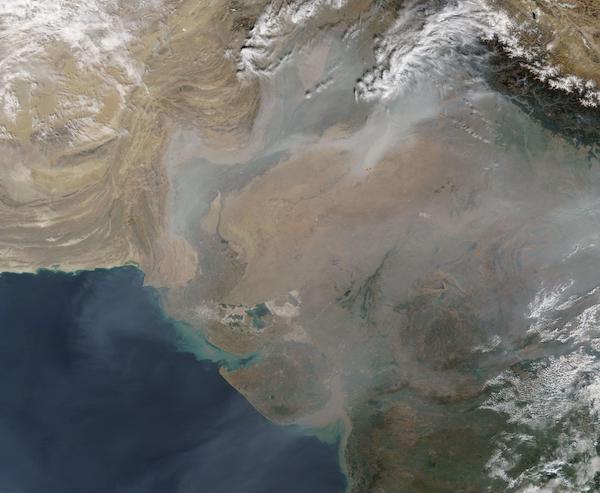Images
November 15, 2020 - Fires Continue in India and Pakistan
Tweet
Hazy skies covered much of northern India through October and mid-November 2020. The Moderate Resolution Imaging Spectroradiometer (MODIS) on board NASA’s Terra satellite acquired a true-color image that gave a snapshot of the continuing haze. The thickest smoke and haze blankets the foothills of the Himalaya Mountains, especially over the Punjab region of India. A river of haze spreads across the Indus River Valley to reach the Arabian Sea. A thinner haze hangs over most of the visible area of India.
Hazy skies are a common occurrence over several states in northern India in November. After crops are harvested, winds often spread a river of smoke across much of the Indo-Gangetic Plain.
Industrial pollution, vehicle emissions and dust contribute to the haze, most of it comes from crop-burning—especially in the states of Punjab and Haryana, where rice and wheat are widely grown. Burning typically peaks during the first week of November, a time when many farmers set fire to leftover rice stalks and straw after harvest, a practice known as stubble or paddy burning. The burning often coincides with falling temperatures and slow wind speeds, meteorological conditions that can lead to temperature inversions, which trap smoke in place.
A review of MODIS imagery from the region shows a few fires popping up in the fertile alluvial fields of Punjab, India on September 29 with only a slight haze over the region. By mid-October, fire activity in India had greatly intensified, with the addition of some fires in northeastern Pakistan. Haze had also greatly increased over the region as well as across India.
Image Facts
Satellite:
Terra
Date Acquired: 11/12/2020
Resolutions:
1km (339.1 KB), 500m (1.2 MB), 250m (3.8 MB)
Bands Used: 1,4,3
Image Credit:
MODIS Land Rapid Response Team, NASA GSFC
Tweet
Hazy skies covered much of northern India through October and mid-November 2020. The Moderate Resolution Imaging Spectroradiometer (MODIS) on board NASA’s Terra satellite acquired a true-color image that gave a snapshot of the continuing haze. The thickest smoke and haze blankets the foothills of the Himalaya Mountains, especially over the Punjab region of India. A river of haze spreads across the Indus River Valley to reach the Arabian Sea. A thinner haze hangs over most of the visible area of India.
Hazy skies are a common occurrence over several states in northern India in November. After crops are harvested, winds often spread a river of smoke across much of the Indo-Gangetic Plain.
Industrial pollution, vehicle emissions and dust contribute to the haze, most of it comes from crop-burning—especially in the states of Punjab and Haryana, where rice and wheat are widely grown. Burning typically peaks during the first week of November, a time when many farmers set fire to leftover rice stalks and straw after harvest, a practice known as stubble or paddy burning. The burning often coincides with falling temperatures and slow wind speeds, meteorological conditions that can lead to temperature inversions, which trap smoke in place.
A review of MODIS imagery from the region shows a few fires popping up in the fertile alluvial fields of Punjab, India on September 29 with only a slight haze over the region. By mid-October, fire activity in India had greatly intensified, with the addition of some fires in northeastern Pakistan. Haze had also greatly increased over the region as well as across India.
Image Facts
Satellite:
Terra
Date Acquired: 11/12/2020
Resolutions:
1km (339.1 KB), 500m (1.2 MB), 250m (3.8 MB)
Bands Used: 1,4,3
Image Credit:
MODIS Land Rapid Response Team, NASA GSFC




